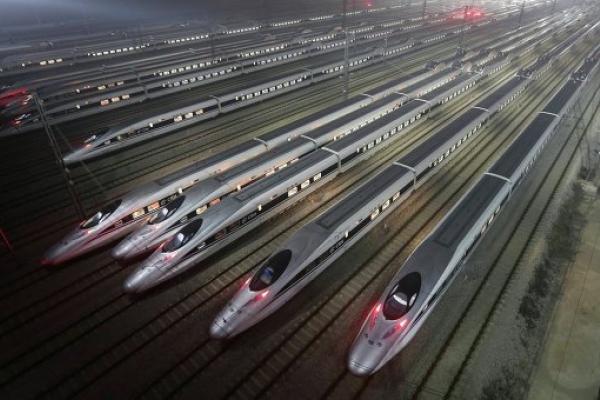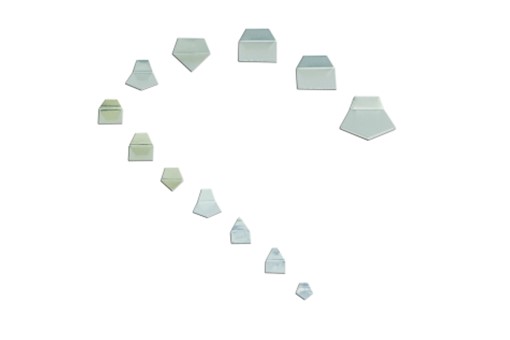Fast but expensive. In Russia, they dream of a high-speed highway "Eurasia", Belarus is still thinking

In August, JSC Russian Railways presented a project of a high-speed railway (HSR) "Eurasia", which should connect CHINA with Western Europe through RUSSIA and Belarus. MINSK has so far refrained from detailed comments on this matter. Either they don't see a subject for discussion yet, or they are afraid of the cost of the Belarusian section of the highway.
Cost - $ 118 billion, speed - 250-350 km / hAccording to the presentation of Russian Railways, "Eurasia" should go from Berlin to Urumqi (China) through Poland, Belarus, Russia and Kazakhstan. The length of the highway is 9.5 thousand km, the cost of construction is 118 billion dollars. Russian Railways predicted that by 2050 the passenger traffic on Eurasia would reach 36.9 million people a year, and the volume of cargo transportation - 12.6 million tons (with the possibility of increasing to 20 million tons). it is assumed that the average speed of trains on the highway will be 250 km/h. Thus, the delivery time of cargo from China to Europe can be less than two days. Now by sea it takes 12-14 days.
The expediency of the project is due to the growing volume of trade in goods with a high added value, sensitive to the delivery time, according to the presentation of Russian Railways. In addition, the volume of e-commerce is increasing, including between China and the EU. The expected additional increase in trade between China and the EU in the period up to 2035 exceeds $720 billion, the document says.
The developers of the HSR Eurasia project expect that the implementation of the project will allow transporting 10-15% of the trade turnover between China and the EU by land transport. Today, the same figure reaches 2%. This will provide the countries of the Eurasian Economic Union with additional income.
The main participants in the project should be the national railways of the EAEU countries: Russian Railways, Belarusian Railways (BZD), Kazakhstan Temir Zholy (KTZ), as well as China's China Railways. Financing - 40% through equity and 60% in the form of loans from financial institutions, TASS reports.
The HSR project can be financed with the participation of the Russian Direct Investment Fund, the BRICS New Development Bank, the Eurasian Development Bank, the Silk Road Fund and the Russian-Chinese Investment Fund, the Russian Railways presentation says.
According to RBC sources familiar with Russian Railways documents and expert assessment, one of the main risks in the Eurasia project is the timing of the launch of all sections of the highway. If any of the sections falls behind the schedule, the launch of transit cargo traffic will not be possible and, accordingly, the indicators of the financial model, freight and passenger traffic will not be met, the source said.
“If the Eurasia project goes at a fast pace, then in general the highway can be built in eight to ten years,” said Alexander Misharin , First Vice President of Russian Railways . According to him, this project will pay off in 16 years of operation.
"The project is still raw"How did Belarus react to the idea of creating a high-speed railway? The HEAD of the railway transport department of the Ministry of Transport of Belarus , Yuri Dubina , in an interview with a TUT.BY correspondent called Eurasia a " large-scale innovative project ." However, the presented materials are not yet enough to estimate the volume of investments, the payback period of the project. “The discussion is currently underway at the level of railway administrations. When the feasibility study of the project is prepared, then the governments will join the discussion,” he explained after the plenary session as part of the Belarusian Transport Week. And although the discussion is taking place with the participation of the Belarusian Railways, Dubina suggested that “ a separate operator company can be created for the project". As for the sources of funding, they can be very different. “Budget funds, credit resources, direct investments… Most likely, it will be carried out within the framework of a separate state program or a public-private partnership. Because the amounts are serious,” said a spokesman for the Ministry of Transport.
The cost of the Eurasia section on the territory of Belarus Krasnoe-Brest is estimated at $13-14 billion. To represent the scale, it is enough to give another figure. In 2011-2016, Belarusian Railways invested $2.5 billion in development, Vladimir Morozov , head of the Belarusian Railways, said during a presentation . Of these, 700 million dollars were investments in the development of the Silk Road routes. The resources were mainly directed to the modernization of infrastructure (in particular, the electrification of sections, the development of the terminal facilities) and the renewal of the rolling stock.
Morozov told reporters that it was too early to comment on Eurasia because " only a business model has been presented ," and as such, there has not yet been a feasibility study for the project.
A source familiar with the progress of the project explained to TUT.BY that "the project has not been fully developed." “There has not yet been a full-fledged discussion with all possible participants in the project. As can be judged from the press, the project has already been criticized in Russia, where experts called it raw,” he said. According to him, at present, with the participation of interested parties, working groups are being formed to work out various issues (financing, legal support, design and construction of the highway, the formation of cargo and passenger flows, and so on). The source stressed that Belarus' project is " theoretically interesting " because it "allows to reload transport corridors and earn extra money on transit."
As for the sources of financing, it is clear that Belarus " cannot pull " such a volume on its own. “The Eurasia project is akin to a nuclear power plant, and even more expensive. I see that funding can come from blocks that are more interested in such a project than Belarus - these are Russia and China,” the source said.
Read together with it:
- India ahead of the G20 summit decided to disperse the monkeys in New DelhiThe Indian authorities have taken preparations seriously for the G20 summit in New Delhi. The city has strengthened security measures and also decided to disperse small monkeys living on the streets of the city by installing special scarecrows for this purpose. A langur figure tied to a fence along the road to scare away the monkeysIn the capital of India, New Delhi, preparations are in full swing...
- Farmers continue to report a shortage of diesel fuelThe relevant associations are appealing to the authorities to take urgent measures to resolve the issue. Thus, the Association of Peasant Farms and Agricultural Cooperatives (AKKOR), in its letter to Prime Minister Mikhail Mishustin (a copy is at the disposal of Agroinvestor), notes that in August prices for diesel fuel for agricultural producers increased sharply - from 54 rubles . /l up to 75 ru...
- Bloomberg learned about the discussion in the EU of a tax on profits from Russian assetsRepresentatives of the EC will hold meetings within the union, at which the introduction of a tax on windfall profits in the amount of €3 billion from the frozen assets of the Central Bank will be discussed, BLOOMBERG has learned . Moscow calls asset confiscation theft View of the building of the Central Bank of RussiaThis week, representatives of the European Commission (EC) will begin meeting wi...
- The Moscow region ranks first in Russia in poultry meat exportsIn the Moscow region, the volume of food supplies abroad continues to grow. “Over the seven months of this year, 56.5 thousand tons of poultry MEAT were exported from the Moscow region. The largest volume of supplies is carried out to CHINA , Belarus, and Kazakhstan . These indicators allowed us to take first place in terms of poultry meat EXPORT volumes in the country,” said Georgy Filimonov, Dep...
- Reuters learned that the G7 does not plan to change the price ceiling for Russian oilThe G7 countries have decided not to revise the price ceiling for Russianoil at $60 a barrel, although some countries in the EU have come up with such an initiative, REUTERS learnedThe G7 countries (Great Britain , Germany , Italy , CANADA , France , Japan and the United States ) do not plan to revise the price ceiling for Russian oil at $6......



























































